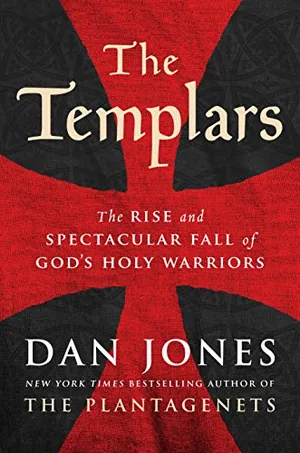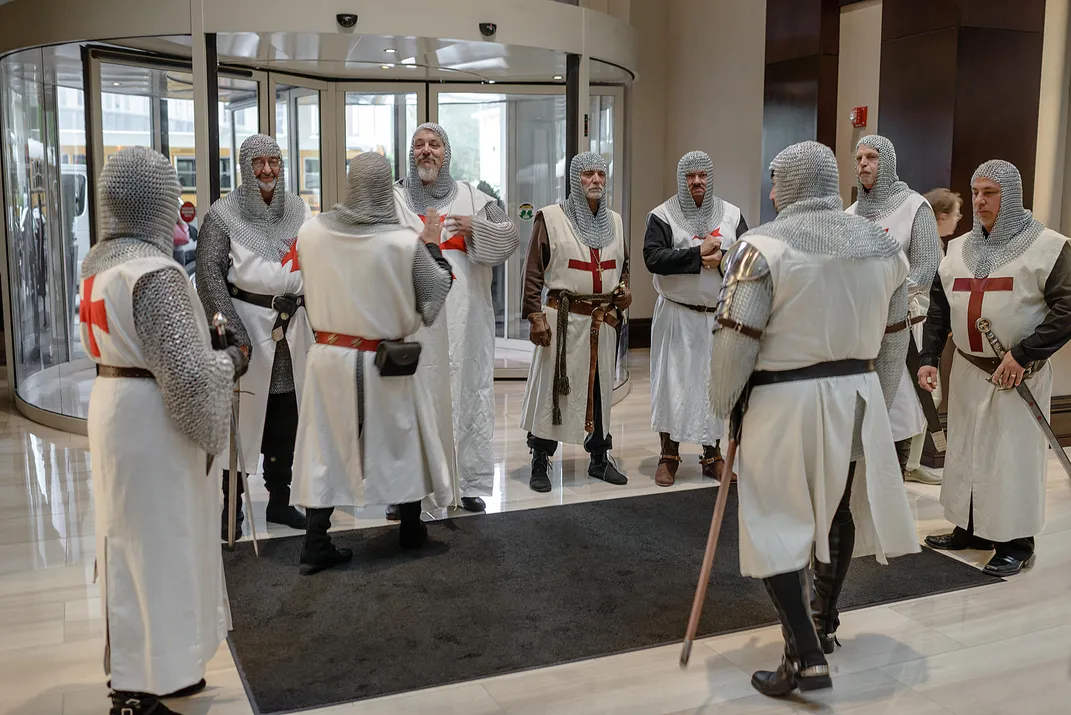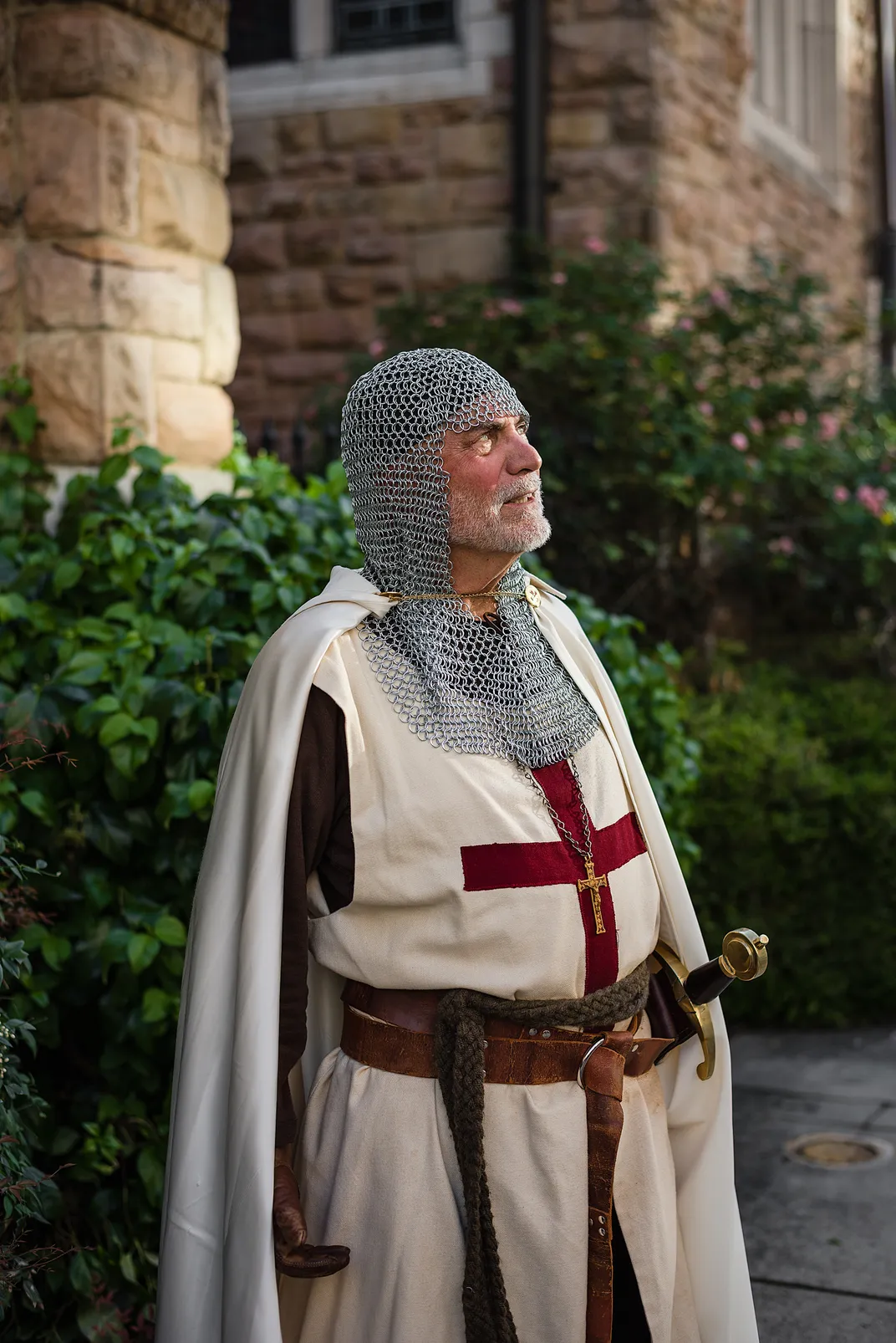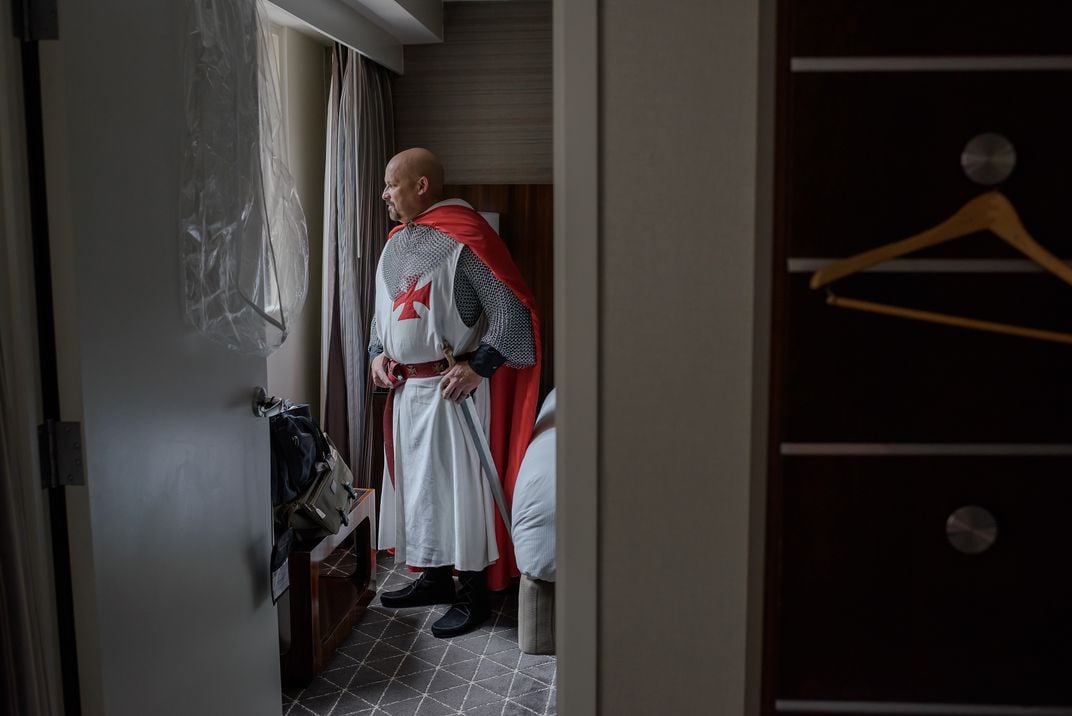Meet the Americans Following in the Footsteps of the Knights Templar
Disbanded 700 years ago, the most famous of the medieval Christian orders is undergoing a 21st century revival
:focal(2409x3017:2410x3018)/https://tf-cmsv2-smithsonianmag-media.s3.amazonaws.com/filer/c9/37/c93719ca-17ec-4b3c-8bfa-667d4e61bf97/julaug2018_a06_prologue.jpg)
Joseph A. Auteri draws his sword and hands it to his Grand Prior, Patrick Carney, who brings it down through a layer of yellow icing, cutting a large birthday cake in half. A couple of hundred people cheer.
The crowd is mostly dressed in business attire, but Auteri is wearing medieval-style armor: a shirt of steel-link mail, a mail coif on his head, plate armor on his shoulders and white linen robes emblazoned with a red cross. The outfit weighs 65 pounds and can cause problems for airline baggage handlers. His sword, modeled on one from the Ridley Scott movie Kingdom of Heaven, is not battle sharp, but it cuts sponge cake easily enough.
By day Joe Auteri, 49, is a partner in a financial planning company based in Pennsylvania. This evening, though, he is Hugh de Payns, a French knight who died in 1136 after establishing a military order known as the Knights Templar.
It is Memorial Day weekend and we are in a hotel in Nashville, Tennessee, where about 350 members of the autonomous Sovereign Military Order of the Temple of Jerusalem have gathered to mark the 900th birthday of the Knights Templar. Members of the charitable organization, known by the unwieldy abbreviation SMOTJ, regard themselves as spiritual descendants of the original Templars. It’s a historical legacy many groups vie for, and in that regard the SMOTJ’s celebration is off to an inauspicious start: Most scholars date the foundation of those first Templars to 1119 or 1120, making the order today just 898 or 899 years old.
No matter. The assembled are eager to get the party started, and the cake-cutting kicks off a weekend that will culminate in the dubbing of seven new “knights” and “dames” in a ritual the official literature says will “prepare you for the great works you have yet to complete.”
/https://tf-cmsv2-smithsonianmag-media.s3.amazonaws.com/filer/cf/72/cf720745-dcfc-4109-ad57-8af3fb890ff8/julaug2018_a04_prologue.jpg)
The original Knights Templar—shorthand for the Order of the Poor Knights of the Temple of Jerusalem—were founded to protect Christian pilgrims on the roads of Palestine following the First Crusade; the group was named for its original headquarters on the Temple Mount. Members were often called “warrior monks,” since they fought on the front line of the crusades and swore oaths of chastity, poverty and obedience.
In their day, though, the Templar organization was rich. It owned property stretching from Britain to Syria, profits from which were used to fund military expeditions in the Holy Land and charitable deeds across the West. The order boasted considerable financial acumen, providing international banking and credit-transfer services. It counted the pope and kings of France among its clients. Its knights were also renowned for bravery in battle—one Muslim writer called them “the fiercest fighters” of all the crusaders.
However, beginning on Friday 13th October 1307 the Templars were destroyed in a process instigated by the French king Philip IV “The Fair” and abetted by Pope Clement V. The Templars had been tainted by the final failure of the crusades in 1291; they were also victims of the French king’s chronic shortage of money. Templar brothers across Europe were arrested, charged with crimes including sodomy, blasphemy and worshiping false idols; they were imprisoned, tortured and forced to make false confessions. In March 1312 a church council formally abolished the order. Its property was confiscated and its members stripped of their rank. In 1314 the last Master, Jacques de Molay, was burned at the stake in Paris.
That grisly demise has lent the Templars lasting notoriety and a thick shrouding of myth. They crop up regularly in modern entertainment, most famously in Dan Brown’s The Da Vinci Code, which cast them as the shadowy guardians of ancient religious secrets, and more recently in the video game franchise Assassin’s Creed, which transforms them into time-traveling supervillains. The Templars have also been widely revived and imitated for purposes both benign and sinister since at least 1737, when the Scottish Freemason Andrew Michael Ramsey wrote a pseudo-history of Masonry that claimed ties to the medieval Templars.
Today Templar revivalism remains strong. Templar iconography is popular with European neo-fascists: The Norwegian mass murderer Anders Breivik claimed to be a Templar, and Knights Templar International is an online network that connects far-right activists, particularly in Britain. In Mexico, a drug cartel called Los Caballeros Templarios has borrowed from Templar symbolism to create its own brand and code of honor. Templar imitation is enduringly popular but seldom historically literate.
Yet the Templars I meet in Nashville are mostly fascinated by the history, at times exhaustingly so. They have recently self-published a long, painstakingly footnoted book about Templarism over the centuries. Their internal literature liberally cites medieval texts such as those of St. Bernard of Clairvaux, who wrote the original Templars’ quasi-monastic rules. For the men and women I encounter, being a 21st-century Templar is about far more than medieval cosplay with a donation cup: It is participation in a living metaphor for evangelical Christian advocacy, financial expertise, internationalism and a militaristic ethos of duty and service to the cause. As Auteri puts it, “The only thing we don’t do is fight.”
SMOTJ was founded in the 1960s under the umbrella of an older, international network of Templar revivalists called Ordo Supremus Militaris Templi Hierosolymitani, which was itself formally recognized by Napoleon Bonaparte in 1805. The worldwide organization claims 5,000 members, 1,500 of whom are the knights and dames of the American SMOTJ. They are attached to 33 priories from Arizona to Wisconsin, and many stay in touch via a closed-membership smartphone app. The SMOTJ is far from the only Templar revivalist organization in the United States: There is a separate Masonic order, and various other non-Masonic groups with online presences. To try to combat confusion, SMOTJ has a legal officer called the Grand Avocat who works on registering trademarks to guard its brand identity.
The Templars: The Rise and Spectacular Fall of God's Holy Warriors
A faltering war in the middle east. A band of elite warriors determined to fight to the death to protect Christianity’s holiest sites. A global financial network unaccountable to any government. A sinister plot founded on a web of lies.
The main function of the tax-exempt SMOTJ is raising money for Christian causes in the Holy Land: funding schools and scholarships in places like Jerusalem, Bethlehem, Bethany and Ramleh, and sponsoring children through Christian schools. Last year donations totaled $407,945. But members also sit in an advisory capacity on committees in the United Nations, and claim informal involvement in international diplomacy. Some dream of one day having the order restored to papal favor with recognition by the Vatican.
There are also perks of membership. It’s good networking, with regular opportunities to wear uniforms, accrue titles and hang out with other like-minded Christians who get a kick from sharing a romantic, medieval past.
Auteri maintains that there is a seriousness to the dress-up. “We are all brought together because of the ideals of a chivalric order,” he says. “It takes a group of people with a common belief and a common cause to stop the persecution and the exile of Christians.” Carney, the outgoing 20th Grand Prior, head of the organization and a smooth-spoken financier, justifies it in simpler but more telling terms: “We belong to the most prestigious order of knighthood on the planet.”
The Episcopal Christ Church Cathedral is packed when the seven new inductees—or “postulants”—take their pews at 3 p.m. on Saturday. The knights and dames who join them wear white mantles with red crosses. Many men wear military formalwear underneath. (The modern order recruits strongly from the officer classes of the U.S. military. In Nashville I meet several one- and two-star generals and many colonels, majors and captains.) A 2-year-old Rottweiler service dog named Tique wears a Templar-themed doggy jacket.
There are plenty of women present: In the 1990s, the order, seeking to maximize membership, forsook medieval rules that argued “the company of women is a dangerous thing...let not ladies be admitted.” One of the postulants is Barbara Prate, a bright, occasionally caustic 45-year-old nurse from New Jersey. She has dressed for the occasion in a red business suit and high heels. Four days ago, Barbara and Joe Auteri got married; between preparing for her own investiture Barbara has been helping Joe in and out of his Hugh de Payns outfit.
The service takes three hours. When the postulants are dubbed, they kneel and Carney taps them on the shoulders with a sword. Another official touches a riding spur to their heels. The night before the ceremony there had been some discussion as to whether the tradition of kneeling is vital. A couple of the postulants are older: One is an elderly ex-Marine who fought in the Korean War and no longer gets up and down easily.
After the dubbings come many awards. I count 27, mostly promotions to various quasi-military orders of merit. There is a ceremonial changing of Grand Prior. The Grand Webmaster is given a meritorious service award. The Grand Archivist gets a medal.
A Muslim data analyst and faith leader from New York is inducted into the order of merit and given white robes (presented without a red cross); he is lauded for bringing faith groups together. I wonder if everyone is pleased. Over lunch one Templar told me, “We don’t want any Muslims,” because followers of Islam “don’t respect anybody.” His diatribe didn’t stop there. Although it is all plainly nonsensical, ambivalence toward Muslims is in tune with Templar history; many of the original order died fighting Islamic armies, yet the 12th-century Syrian writer Usama ibn Munqidh praised the Templars for clearing a space in their chapel in Jerusalem so he could pray toward Mecca.
Once the service is complete, the Templars shuffle out of church and return to their hotel for a cocktail reception and dinner. During the meal I feel a hand on my shoulder, and a knight whose name I do not catch leans in and whispers conspiratorially, “We were there”—I assume he means the Holy Land—“for 160 years, and they tried to kick us out but we survived.”
“Don’t forget, we were God’s shock troops.”
This is pure fantasy. But on balance, the expressions of historicist foolishness and idle prejudice are few compared with accounts of money donated and distributed to schoolchildren in faraway lands, and advocacy for peace through respectable bodies by organizations like the U.N.
Later, as the night winds down, we stand on a roof terrace overlooking the street outside the hotel. Honky-tonk music drifts up from the bars below. Two dozen or so Templars—mostly middle-aged guys—are killing beers and whiskey and chomping fat cigars. A couple are talking about St. Bernard of Clairvaux’s philosophy. Others are brainstorming ways to raise money for Templar archaeology in Israel. A retired general discusses the possibility of using contacts in the worldwide organization to conduct back-channel diplomacy between the United States and Russia.
They are all in earnest, and having the time of their lives. I think of something a fellow guest sitting next to me in church said as we sat through the many medal-givings and commendations earlier.
“There’s a lot of batshit crazy here,” she murmured. “All of it with good intent.”
Editor’s note: An earlier version of this story misidentified the person who cut the cake. It was Patrick Carney.
A Note to our Readers
Smithsonian magazine participates in affiliate link advertising programs. If you purchase an item through these links, we receive a commission.



